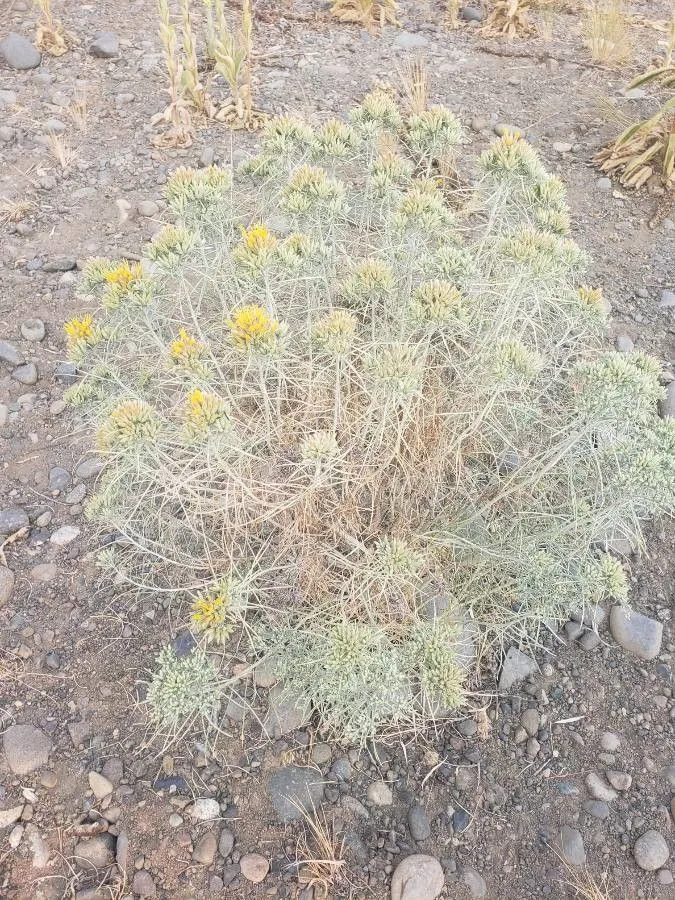
Author: Nutt.
Bibliography: Trans. Amer. Philos. Soc., ser. 2, 7: 324 (1840)
Year: 1840
Status: accepted
Rank: species
Genus: Chrysothamnus
Vegetable: False
Observations: W. Canada to W. & C. U.S.A.
Sticky-leaf rabbitbrush, scientifically known as Chrysothamnus viscidiflorus, is a resilient shrub native to the western and central regions of North America, spanning from western Canada down through the western and central United States. This plant is a member of the Asteraceae family, a large and diverse family known for its flowering species.
First described by the noted botanist Nuttall in 1840, as documented in the Transactions of the American Philosophical Society, sticky-leaf rabbitbrush is recognized for its distinctive sticky leaves, which give the plant its common name. These leaves and the clusters of small, yellow flowers it produces make it a notable feature in its native habitats.
Sticky-leaf rabbitbrush often thrives in dry, rocky environments and is a vital component of the sagebrush ecosystem. Its ability to tolerate poor soil and drought conditions makes it an important plant for erosion control and habitat restoration efforts. The plant not only provides cover for wildlife but also acts as a food source for various insects and animals.
In addition to its ecological importance, sticky-leaf rabbitbrush has been utilized in traditional herbal remedies by indigenous peoples of North America, and it’s valued for its potential in landscaping due to its hardiness and aesthetic appeal.
Whether used for ecological projects or admired in its natural setting, sticky-leaf rabbitbrush stands as a testament to the rugged beauty and ecological diversity of the regions it inhabits.
Eng: douglas rabbitbrush, douglas’ rabbitbrush, green rabbitbrush, sticky-leaf rabbitbrush, yellow rabbitbrush, yellowbrush, sticky-leaved rabbitbrush
Fra: bigelovie visqueuse
En: Sticky-leaf rabbitbrush, Yellow rabbitbrush, Douglas rabbitbrush, Yellowbrush, Douglas’ rabbitbrush, Green rabbitbrush, Sticky-leaved rabbitbrush
Fr: Bigelovie visqueuse
Nv: Chʼil dilyésiitsoh
Taken Mar 8, 2021 by Taylor Shook (cc-by-sa)
Taken Aug 27, 2022 by Monica mlm38 (cc-by-sa)
Taken Jul 31, 2021 by Valerie Mason (cc-by-sa)
Taken Oct 2, 2021 by Krystal Dittmer (cc-by-sa)
Taken Aug 23, 2022 by Christine MARLOT (cc-by-sa)
Taken Jul 31, 2021 by Valerie Mason (cc-by-sa)
Taken Sep 24, 2022 by aithena munkyfunk (cc-by-sa)
Taken Oct 21, 2011 by EOL − Jim Morefield (cc-by-nc-sa)
Taken Aug 12, 2020 by Dicy A (cc-by-sa)
Taken Oct 6, 2021 by Autumn McClintock (cc-by-sa)
Taken Jan 1, 1900 by EOL − USDI BLM. United States, CA, Mono Co. October 2003. (public)
Taken Sep 16, 2014 by EOL − Richard Spellenberg (cc-by-nc-sa)
Taken Nov 15, 2013 by EOL − Ben VanderWeide (cc-by-nc)
Taken Nov 7, 2014 by EOL − Richard Spellenberg (cc-by-nc-sa)
Taken Aug 19, 2021 by Cade Lillquist (cc-by-sa)
Taken Oct 10, 2022 by Cynthia Brinkley (cc-by-sa)
Taken Oct 12, 2022 by Joseph Littlehorn (cc-by-sa)
Growth form>: Multiple Stem
Growth habit>: Shrub
Growth rate>: Moderate
Ph maximum: 8.5
Ph minimum: 7.0
Family: Myrtaceae Author: (F.Muell.) K.D.Hill & L.A.S.Johnson Bibliography: Telopea 6: 402 (1995) Year: 1995 Status:…
Family: Rubiaceae Author: Pierre ex A.Froehner Bibliography: Notizbl. Bot. Gart. Berlin-Dahlem 1: 237 (1897) Year:…
Family: Sapindaceae Author: Koidz. Bibliography: J. Coll. Sci. Imp. Univ. Tokyo 32(1): 38 (1911) Year:…
Family: Asteraceae Author: A.Gray Bibliography: Pacif. Railr. Rep.: 107 (1857) Year: 1857 Status: accepted Rank:…
Family: Fabaceae Author: Medik. Bibliography: Vorles. Churpfälz. Phys.-Ökon. Ges. 2: 398 (1787) Year: 1787 Status:…
Family: Aspleniaceae Author: (Cav.) Alston Bibliography: Bull. Misc. Inform. Kew 1932: 309 (1932) Year: 1932…